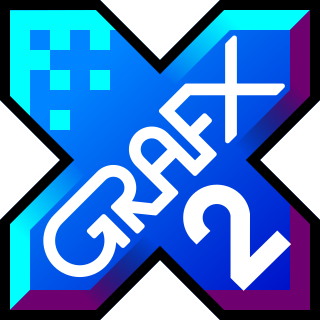
Lotus 1-2-3 is a discontinued spreadsheet program from Lotus Software. It was the IBM PC's first killer application, was hugely popular in the 1980s and contributed significantly to the success of the IBM PC.
IBM PC compatible computers are similar to the original IBM PC, XT, and AT that are able to use the same software and expansion cards. Such computers were referred to as PC clones, or IBM clones. The term "IBM PC compatible" is now a historical description only, since IBM no longer sells personal computers. The industry jargon "PC" sometimes doesn't mean "personal computer" generally, but rather a computer running Microsoft Windows, in contrast to Apple's Mac.

Morphing is a special effect in motion pictures and animations that changes one image or shape into another through a seamless transition. Traditionally such a depiction would be achieved through dissolving techniques on film. Since the early 1990s, this has been replaced by computer software to create more realistic transitions.

A workstation is a special computer designed for technical or scientific applications. Intended primarily to be used by one person at a time, they are commonly connected to a local area network and run multi-user operating systems. The term workstation has also been used loosely to refer to everything from a mainframe computer terminal to a PC connected to a network, but the most common form refers to the class of hardware offered by several current and defunct companies such as Sun Microsystems, Silicon Graphics, Apollo Computer, DEC, HP, NeXT and IBM which opened the door for the 3D graphics animation revolution of the late 1990s.

PagePlus was a desktop publishing program developed by Serif for Microsoft Windows. The first version was released in 1991 as the first commercial sub-£100 DTP package for Microsoft Windows. The final release was PagePlus X9, which was released in November 2016. In June 2019 it was officially replaced by Serif with Affinity Publisher.

VisiCorp Visi On was a short-lived but highly influential graphical user interface-based operating environment program for IBM compatible personal computers running MS-DOS. Although Visi On was never popular, as it had steep minimum system requirements for its day, it was a major influence on the later development of Microsoft Windows.

Hauppauge Computer Works is a US manufacturer and marketer of electronic video hardware for personal computers. Although it is most widely known for its WinTV line of TV tuner cards for PCs, Hauppauge also produces personal video recorders, digital video editors, digital media players, hybrid video recorders and digital television products for both Windows and Mac. The company is named after the hamlet of Hauppauge, New York, in which it is based.
Radius was an American computer hardware firm founded in May 1986 by Burrell Smith, Andy Hertzfeld, Mike Boich, Matt Carter, Alain Rossmann and other members of the original Macintosh team. The company specialized in Macintosh peripherals and accessory equipment. It completed its IPO in 1990.

Joseph Paul Montgomery was an American entrepreneur and inventor. In the mid 1980s, he was among the first to see the potential of personal computer technology in the field of video production and 3D animation. As Vice President of NewTek and Co-Founder and President of Play, Inc., Montgomery drove the creation of the first widely-successful digital video products, including the Emmy-award-winning Video Toaster and the Snappy Video Snapshot.

Lotus Magellan is an MS-DOS desktop search package, conceived and developed by Bill Gross and released in 1989 by Lotus Development Corporation, most famous for Lotus 1-2-3. Lotus sold 500,000 copies of Magellan.

NeoPaint is a raster graphics editor for Windows and MS-DOS. It supports several file formats including JPEG, GIF, BMP, PNG, and TIFF. The developer, NeoSoft, advertises NeoPaint as being simple enough for use by children while remaining powerful enough for the purposes of advanced image editing.

Elastic Reality was a warping and morphing software application available on Windows, Macintosh, Silicon Graphics workstations and Amigas and was discontinued in 1999.
The 3DO Blaster is an add-on produced by Creative Labs and designed to allow compatible Windows-based PCs to play games for the 3DO Interactive Multiplayer. It is a full-sized ISA compatibility card, and unlike other such add-ons, it does not emulate a 3DO system, but rather the whole system's logic board is included, with the input (controllers) and output redirected to the PC.
CPT Corporation was founded in 1971 by Dean Scheff in Minneapolis, Minnesota, with co-founders James Wienhold and Richard Eichhorn. CPT first designed, manufactured, and marketed the CPT 4200, a dual-cassette-tape machine that controlled a modified IBM Selectric typewriter to support text editing and word processing.
This article deals with productivity software created for the Amiga line of computers and covers the AmigaOS operating system and its derivates AROS and MorphOS and is a split of main article Amiga software. See also related articles Amiga Internet and communications software, Amiga music software, Amiga programming languages, and Amiga support and maintenance software for other information regarding software that run on Amiga.

A personal computer (PC) is a multi-purpose computer whose size, capabilities, and price make it feasible for individual use. Personal computers are intended to be operated directly by an end user, rather than by a computer expert or technician. Unlike large costly minicomputers and mainframes, time-sharing by many people at the same time is not used with personal computers.
This article presents a timeline of events in the history of 16-bit x86 DOS disk operating systems from 1980 to 2016. Other operating systems named "DOS" are generally not part of the scope of this timeline.

GrafX2 is a bitmap graphics editor inspired by the Amiga programs Deluxe Paint and Brilliance. It is free software and distributed under GNU General Public License.

Wyse is an American manufacturer of cloud computing systems. They are best known for their video terminal line introduced in the 1980s, which competed with the market leading Digital. They also had a successful line of IBM PC compatible workstations in the mid-to-late 1980s, but were outcompeted by companies such as Dell starting late in the decade. Current products include thin client hardware and software as well as desktop virtualization solutions. Other products include cloud software-supporting desktop computers, laptops, and mobile devices. Dell Cloud Client Computing is partnered with IT vendors such as Citrix, IBM, Microsoft, and VMware.
Fatpaint is a free, online (web-based) graphic design and desktop publishing software product and image editor. It includes integrated tools for creating page layout, painting, coloring and editing pictures and photos, drawing vector images, using dingbat vector clipart, writing rich text, creating ray traced 3D text logos and displaying graphics on products from Zazzle that can be purchased or sold. Fatpaint integrates desktop publishing features with brush painting, vector drawing and custom printed products in a single Flash application. It supports the use of a pressure-sensitive pen tablet and allows the user to add images by searching Wikimedia, Picasa, Flickr, Google, Yahoo, Bing and Fatpaint's own collection of public domain images. The completed project can be saved on Fatpaint's server or locally. Fatpaint is affiliated with Zazzle and owned by Mersica.












